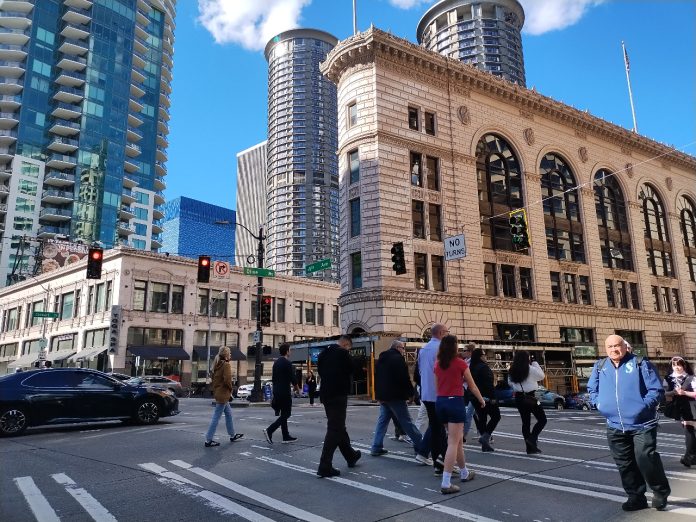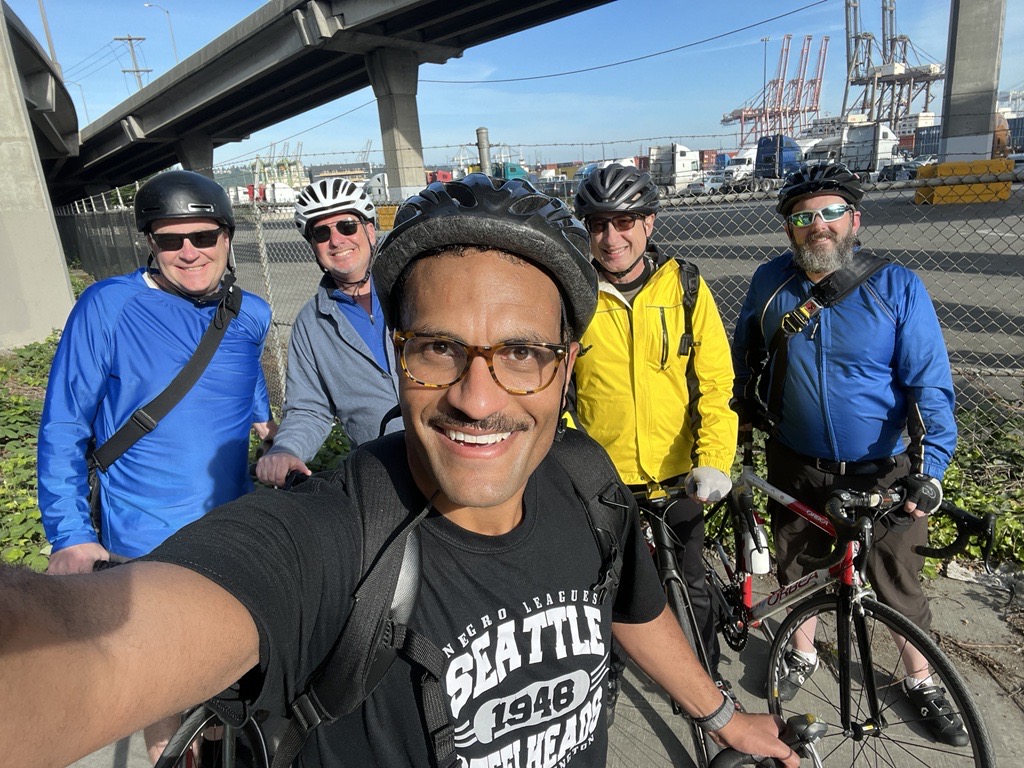
Advocates are watching intently to see how the Seattle City Council will modify the $1.45 billion, eight-year transportation levy that Mayor Bruce Harrell’s administration added finishing touches to early this month. The council’s select committee on the levy, made up of all nine councilmembers, has just three scheduled meetings left before a final vote on the proposal is scheduled in early July, in time to meet the county’s deadline to send it to the ballot this November. So far, signals from councilmembers about their specific priorities have been few and far between.
Late last week, committee chair Rob Saka (D1, West Seattle) sent out a list of six “guiding principles” that he says he’s using to approach the levy renewal. Saka will be shepherding the amendments over the coming weeks, and many councilmembers will likely be following his lead. Number one on his list of principles? “Recognize the importance of ALL modes of travel.”
“Walking, biking, transit, cars, trucks (including those moving critical cargo and freight!), and more,” Saka continued. “We must expand transportation choices and incentives to keep us all moving safely and efficiently.”
Many Seattle transportation advocacy groups already find the Mayor’s proposal to be out of balance, with less than 40% of the funding set to be spent on pedestrian, bike, transit, and traffic safety programs. They want a larger levy with at least 50% dedicated to safety upgrades and transit. Advocates point to independent polling that shows that a $1.9 billion levy, 30% larger than the one the Harrell administration has proposed, with majority support if respondents are told about additional transportation investments that could be funded.
While his exact funding priorities are unclear, Saka is hinting at making more than minor changes to the Mayor’s proposal.
“I am focused on putting a final package before voters that reflects a balanced approach,” Saka wrote. “We need a levy ambitious enough to ensure that we have a safe, reliable, and efficient transportation infrastructure, not just for today, but for decades to come. On the other hand, we need to be programmatically precise with this funding, optimizing our investments to the areas of greatest need and impact. This includes a heavy emphasis on bridges, roads, potholes, and new sidewalks. EVERYONE benefits when we prioritize these types of nitty-gritty details that make a difference in people’s everyday lives.”
Saka has already made a point of trying to publicly demonstrate his visible support for all modes, touting his participation in some Bike Everywhere month events, including a ride from West Seattle to Downtown with Seattle Department of Transportation (SDOT) staff. But so far, he hasn’t had to translate this idea into policy in his role as chair of the council’s transportation committee. The unanimous adoption of the massive Seattle Transportation Plan earlier this year happened largely without any substantive amendments, with the council rubber stamping a plan developed by the Harrell Administration that does include some bold ideas for how to transform the city’s transportation system over the next two decades but few specifics on how exactly Seattle will get there.

Also on the list of Saka’s stated priorities: “Uplift a ‘bold basics’ approach”, “Strengthen safety and improve accessibility”, “Prioritize “good governance” and wise investment of tax dollars,” “Advance climate action, sustainability, and resiliency,” and finally, “Fair and just implementation of the [Seattle Transportation Plan].”
Calling for a “balanced” transportation system that prioritizes all modes has long been a dog whistle for supporting a car-oriented status quo, given the decades of investments that have already tipped the scales. Saka heads into the amendment discussion without a transportation expert directly on his staff, after former SDOT program manager Heather Marx, who Saka had hired at the beginning of 2024, departing his office early this month. That means for expertise the entire council will be relying heavily on its independent central staff, including transportation expert Calvin Chow.
As a private citizen, Saka took steps to try and get a multimodal project intended to improve safety watered down, contacting SDOT staff in 2021 and 2022 about a traffic barrier installed as part of the RapidRide H project on Delridge Way and comparing it to the national border wall proposed by former President Donald Trump. PubliCola detailed his emails to city staff earlier this year in which he described the barrier as an “errant decision.”
So far as transportation chair, Saka has mostly stayed out of project-level discussions, though he recently did weigh in on SDOT’s plans to make a Stay Healthy Street in Alki Point permanent. Following heated local opposition due to planned parking removal, Saka stated a strong desire to see the Alki pedestrianization project fully evaluated after it was implemented.
At the first of two scheduled public hearings on the levy proposal in mid-May, which was lightly attended by fewer than 20 speakers, the majority of comments were asking the council to either keep spending at the level proposed by the Mayor or go even bigger. One of the speakers was Lilly Hayward, speaking on behalf of the Seattle Metropolitan Chamber of Commerce, who asked the council to keep the levy at $1.45 billion, but requested that the council reallocate additional funding within the levy to freight improvements. Earlier in the day, Saka referenced a desire to also focus on freight
Seattle’s freight advisory board, in late April, requested that the city double the amount of money dedicated to freight improvements in the levy from $25 million to $50 million, without identifying any specific projects that the money should be spent on. The 2015 levy included $39 million for freight, but that number included $25 million for two specific projects that had long been priorities for freight advocates — the Lander Street overpass and the rebuild of East Marginal Way to heavy haul standards.
The freight spot improvements program, which pays for much smaller individual freight-related upgrades around the city, would be set to increase from $14 million to $25 million. The proposed program doubling comes despite little visibility available to the general public into what the program actually does. Increasing the amount even further — without increasing the total of the levy itself — would mean decreasing the amount set to go to another program.
Next week’s second and final public hearing occurs in the wake of one of the most deadly weeks on Seattle’s streets in several years, with six separate fatal collisions between last Thursday and this Wednesday, including three pedestrians killed by drivers, along Olive Way, 12th Avenue S, and Aurora Avenue N, respectively. All five crashes occurred on segments of SDOT’s “high crash network” map illustrating which streets are most in need of safety upgrades.

Among the potential ways the council could amend the proposal is by shifting funding around from one program to another, by directing the city to spend levy dollars on specific projects, or by adding specific guardrails that will corral future spending. At a committee meeting earlier this month, Councilmember Tammy Morales expressed a desire to see the city shift away from prioritizing the number of projects it completes and toward the outcomes that the city wants to see.
“I am tired of coming to briefing and talking about my constituents who have been killed because our roads are not safe,” Morales said. “I want us to remember that we’re here for all of our constituents, but we are really here for the folks who are not typically at the table, and really not able to advocate for themselves because they have busy lives trying to do other things. And I think it’s going to be very important for us to step into our leadership and make sure that we’re protecting everybody in the city.”
In his comments, Saka has signaled both a desire to keep future transportation funding priorities flexible, but also for the council to add language to the levy that will guide outcomes, a tall order for even an experienced city council.
“My initial impressions of this levy […] at a high level, it’s a strong ‘back to basics’ [levy],” Saka said. “And I think over time, over the course of the next couple sessions, we’ll have an opportunity to more closely examine proposed investment categories and the adequacy and sufficiency of various investment categories, in relation to other priorities, including sidewalks, freight cargo mobility, EV charging, roads, and of course, the stuff that is not going to get any headlines whatsoever, but it’s what I think voters elected us to do, and that’s good old fashioned good governance provisions: the unsexy, unglamorous things that help drive performance and therefore help drive impact.”
The final public hearing on the transportation levy is set for Tuesday, June 4, at 4:30pm. Earlier that day, Saka will introduce his own amendments to the proposal, with amendments from other councilmembers not set to be released until June 18.
Ryan Packer has been writing for The Urbanist since 2015, and currently reports full-time as Contributing Editor. Their beats are transportation, land use, public space, traffic safety, and obscure community meetings. Packer has also reported for other regional outlets including BikePortland, Seattle Met, and PubliCola. They live in the Capitol Hill neighborhood of Seattle.

